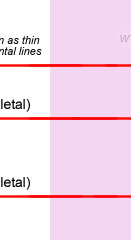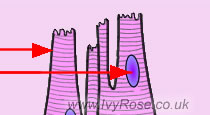There are 3 types of muscle tissue:
- Skeletal muscle tissue,
- Cardiac muscle tissue, and
- Smooth muscle tissue.
The structure of these muscle tissues can be described from the level of detail of the muscle fibres (muscle cells) through all the other muscle structures and parts of structures that bind muscle cells together enabling them to perform their functions.
The functions of muscle tissues depend on the type of muscle tissues and their locations in the body.
Here is an overview of the 3 types of muscle tissues:
 |
(a) Skeletal Muscle Tissue
|
| |
Structure:
Skeletal muscle is called "striated" because of its appearance consisting of light and dark bands visible using a light microscope. As shown in the diagram (on the right), a single skeletal muscle cell is long and approximately cylindrical in shape, with many nuclei located at the edges (periphery) of the cell.
Function:
- Movement of the skeleton under concious control, including movement of limbs, fingers, toes, neck, etc.
- Movement of tissues of facial expression under concious control, e.g. ability to smile and to frown.
|
Above: Diagram of Skeletal Muscle Tissue
|
|
|
(b) Cardiac Muscle Tissue
|
| |
Structure:
Cardiac muscle fibers are striated, branched (sometimes described as Y-shaped), and have a single central nucleus. These fibers are attached at their ends to adjoining fibers by thick plasma membranes called intercalated discs (shown in digram on the right).
Function:
- Pumping of blood through the heart: Alternate contraction and relaxation of cardiac muscle pumps
- De-oxygenated blood through the Right Atrium and Right Ventricle to the lungs, and
- Oxygenated blood through the Left Atrium and Left Ventricle to the aorta, then the rest of the body.
|
Above: Diagram of Cardiac Muscle Tissue
|
|
(c) Smooth Muscle Tissue
|
| |
Structure:
Unlike Skeletal and Cardiac muscle tissue, Smooth muscle is not striated. Smooth muscle fibers are small and tapered - with the ends reducing in size, in contrast to the cylindrical shape of skeletal muscle. Each smooth muscle fiber has a single centrally located nucleus.
Function: Contractions of smooth muscle constrict (i.e. narrow = reduce the diameter of) the vessels they surround. This is particularly important in the digestive system in which the action of smooth muscle helps to move food along the gastrointestinal tract as well as breaking the food down further. Smooth muscle also contributes to moving fluids through the body and to the elimination of indigestible matter from the gastrointestinal system.
|
Above: Diagram of Smooth Muscle Tissue
|
|














